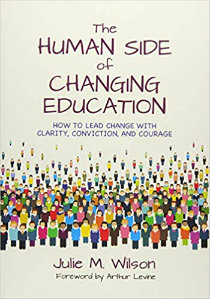The Human Side of Changing Education
The Human Side of Changing Education: How to Lead Change with Clarity, Conviction, and Courage
By Julie M. Wilson
(Corwin, 2018 – Learn more)
“Oh my gosh! When will I ever use this?!?”
No, I’m not talking about Julie M. Wilson’s The Human Side of Changing Education. I’m talking about the question that too often I have asked myself as I finish up any of my professional learning experiences (university course work, book, article, conference, etc.).
I really strive to make it a point to walk away from learning opportunities feeling confident that I will be able to use at least one strategy or knowledge “tidbit” in my position as a middle school principal in the very near future.

Currently, in my position as a school administrator, I am developing my skills in the Human Resources management aspect of my job – especially as it pertains to helping staff deal with change. This can be challenging because in the business of education, we are dealing with more than numbers or widgets. We are dealing with human beings.
Human beings have background stories and bring unique talents, obstacles, coping skills, and emotions to work. If we are going to successfully change education for the benefit of the students, educational leaders (formal and informal) need to take into account all that people are bringing with them to the table.
I started my search by looking for research articles from reputable professional journals and recommendations from websites, blogs, etc. Thankfully, I stumbled upon Julie M. Wilson’s book, The Human Side of Changing Education: How to Lead Change with Clarity, Conviction, and Courage (2018), through MiddleWeb. I thought that it hit the mark!
Tools for my everyday practice
After the quick read (and I am a slow reader, so that says something right there), I was able to walk away with a handful of practical strategies and tools for me to use in my everyday practice. In fact, by the time that this review is published, I may just have implemented the majority of my list.
Wilson sets up her book in a fashion that makes it more than possible for a “busy professional” to make efficient use out of what’s inside. If you don’t want to have to read the full chapter, you can check out the Key Points at the end of each chapter. Then you can decide whether or not you want to dive deeper into the discussion. If you make the choice to dive deeper, you’ll find those wonderful knowledge tidbits.
From theory to reflection
Each of the five chapters begins with some theoretical background foundation, but then leaves the reader with at least one practical strategy to address what is discussed. Better yet, for those reflective practitioners who like to self-study, each chapter ends with multiple reflection questions. When I took on those reflection questions, I really found that I was able to make sense of all that was being touched upon in the chapter and apply it immediately to my situation.
There are two chapters that I found particularly helpful, the first being Chapter 4 – Leading Your Organization Through Change: Strategies. The most helpful for me was Strategy #5 from that chapter. This strategy reminded me that change is not something that happens quickly; it takes time and it is not a linear process. It may take five to seven years before you get those changes where you want them, but they do, and will, happen. The leader’s role is to help others through that “craziness” and come out better on the other side.
A Strengths-based resource
I’m also a strong proponent of the Strengths-based approach that is advocated throughout the book. Currently, my school is doing a lot of work with Gallup, the Strengths-finder 2.0, and Strengths-based Teaching/Leadership. So when I saw the Strengths-based Conversation script, mentioned in Chapter 4, I was elated. Something I could apply tomorrow! I recommend that tool for anyone who operates within the Strengths-based philosophy (and even to those who do not).
Leading school change can be difficult too; right?!? Chapter 5 of Wilson’s book deals with getting yourself, as the leader, through the change process as well. This was refreshing. Often times, I feel as though school leaders are overlooked and lack the supports we need to navigate change initiatives and our own human struggles.
Wilson shares the concept of The Hero’s Journey with her readers. This allowed me to find my place on my journey and give me a sense of where I have been and where I want to go. It was amazing that something as simple as this “map” of a leader’s journey really provided me a sense of what I have accomplished and will accomplish.
Lastly, the Appendix of this book provides wonderful resources (one being the Strengths-based Conversation script) that can be applied to assist a building-level or district-level school leader with the change process.
Bottom line: Julie Wilson does a very nice job of providing resources to educational leaders for dealing with the human element during the change process.
At the end of my career, I would love to be able to teach a class on Usus Meditando (Practical Knowledge) for educators. Julie Wilson’s The Human Side of Changing Education just made the required reading list.
Michael Whisler is the principal at Marinette Middle School (Marinette, WI). He received his Bachelor’s and Master’s degrees from the University of Wisconsin – Madison. Being a strong middle school advocate, Whisler recognizes that it takes a special person to be a middle school educator. Seventeen of the last eighteen years, he has worked with 5th grade – 8th grade students. Without the support of his wife Abby, also an educator, none of this would be possible.




































